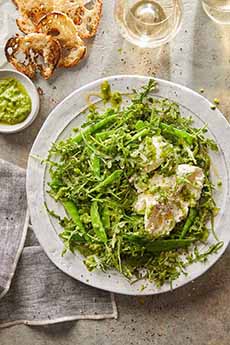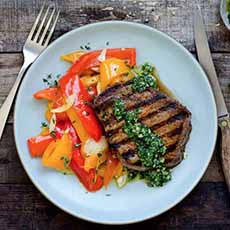TIP OF THE DAY: Pesto Beyond Pasta
|
|
You may enjoy pesto on pasta, but what about beyond? Pesto sauce traditionally* consists of basil, garlic, olive oil, pine nuts, Parmesan and Pecorino cheeses. Salt is added for seasoning. Here’s a recipe for homemade pesto. If you’d like to try other ingredients—cheeses, greens, nuts, oils—here’s a list of options. Pesto originated in the Italian province of Liguria, where plots of sweet basil were plentiful. (The capital city of Liguria, Genoa, is the home of Christopher Columbus.) Ligurians invented pesto sauce, crushing the ingredients with a mortar and pestle into a paste (pesto means paste in Italian). Varying the amount of olive oil created a thinner sauce or a thicker spread. It’s easy to make pesto at home. If you don’t have a mortar and pestle†, you can pulse the ingredients in a food processor. Note: We tried it both ways, and the ground mortar and pestle version actually tasted more vibrant than the pulsed pesto. We prefer it, unless we don’t want to take the extra time. Here’s the classic recipe, plus tips to make a better pesto: Or, freeze it. 15 Pesto Use Recipes |
|
|
________________
*Today, cooks switch out the ingredients to make modern pestos: different herbs or green vegetables, nuts and cheeses. †The mortar is the bowl, the pestle is the grinding tool. They were used to make both medicine and food. Ancient mortars and pestles found in Southwest Asia date back to approximately 35000 B.C.E. If that seems like a ridiculously long time ago, Homo sapiens evolved in Africa 300,000 years ago [source]. The English word mortar derives from classical Latin mortarium, meaning, among other things, both receptacle for pounding and the product of grinding or pounding. The classical Latin pistillum, meaning “pounder,” evolved into the English pestle [source]. |
||


